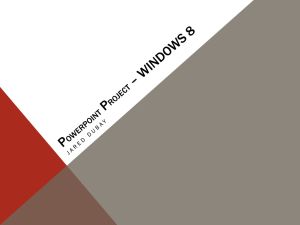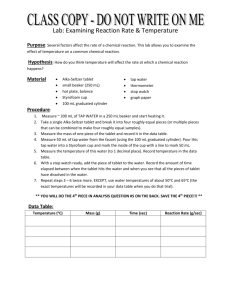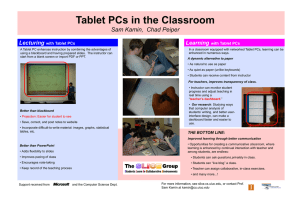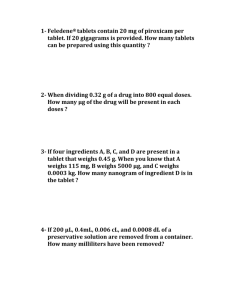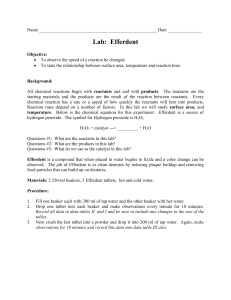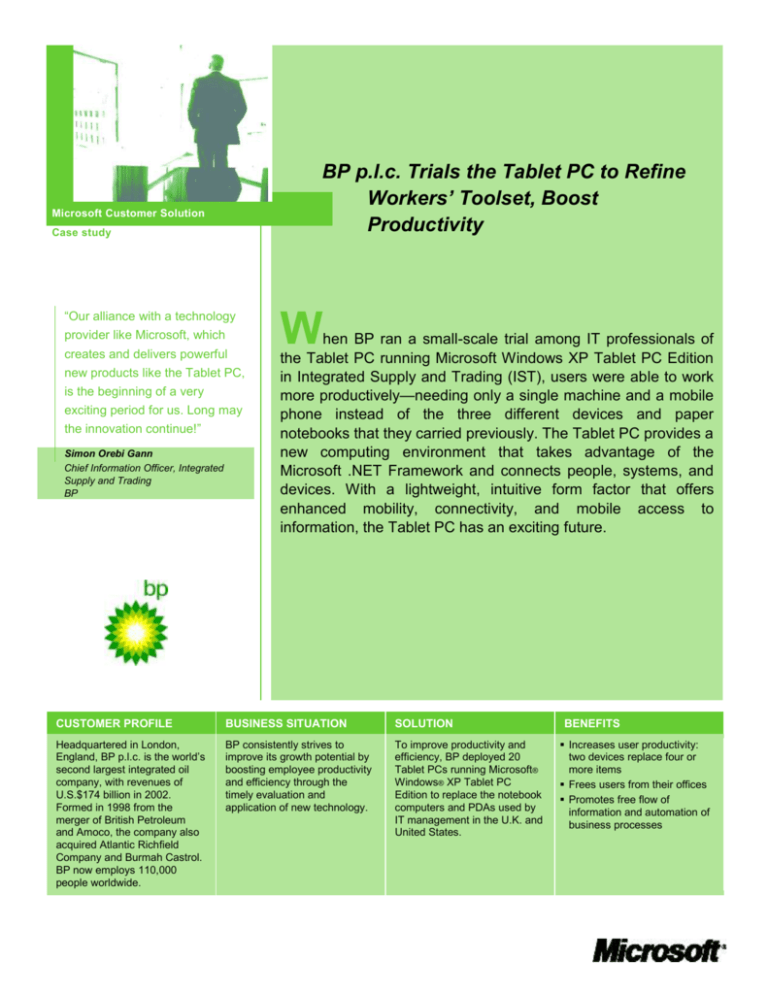
BP p.l.c. Trials the Tablet PC to Refine
Workers’ Toolset, Boost
Productivity
Microsoft Customer Solution
Case study
Case Study
“Our alliance with a technology
provider like Microsoft, which
creates and delivers powerful
new products like the Tablet PC,
is the beginning of a very
exciting period for us. Long may
the innovation continue!”
Simon Orebi Gann
Chief Information Officer, Integrated
Supply and Trading
BP
W
hen BP ran a small-scale trial among IT professionals of
the Tablet PC running Microsoft Windows XP Tablet PC Edition
in Integrated Supply and Trading (IST), users were able to work
more productively—needing only a single machine and a mobile
phone instead of the three different devices and paper
notebooks that they carried previously. The Tablet PC provides a
new computing environment that takes advantage of the
Microsoft .NET Framework and connects people, systems, and
devices. With a lightweight, intuitive form factor that offers
enhanced mobility, connectivity, and mobile access to
information, the Tablet PC has an exciting future.
CUSTOMER PROFILE
BUSINESS SITUATION
SOLUTION
Headquartered in London,
England, BP p.l.c. is the world’s
second largest integrated oil
company, with revenues of
U.S.$174 billion in 2002.
Formed in 1998 from the
merger of British Petroleum
and Amoco, the company also
acquired Atlantic Richfield
Company and Burmah Castrol.
BP now employs 110,000
people worldwide.
BP consistently strives to
improve its growth potential by
boosting employee productivity
and efficiency through the
timely evaluation and
application of new technology.
To improve productivity and
efficiency, BP deployed 20
Tablet PCs running Microsoft®
Windows® XP Tablet PC
Edition to replace the notebook
computers and PDAs used by
IT management in the U.K. and
United States.
BENEFITS
Increases user productivity:
two devices replace four or
more items
Frees users from their offices
Promotes free flow of
information and automation of
business processes
“For someone thinking about
work on the commute home, the
Tablet PC is the perfect tool for
turning thoughts into productive
action.”
David Newton
IT Strategy Director, Integrated Supply
and Trading
BP
BP is one of the world’s largest petroleum
and petrochemicals groups. Its main
activities are exploration and production of
crude oil and natural gas; refining,
marketing, supply, and transportation; and
the manufacturing and marketing of
petrochemicals. BP has proved reserves of
15.2 billion barrels of oil equivalent,
including large holdings in Alaska. It is the
largest U.S. oil and gas producer. The
company is also a top refiner (it has a
capacity of 3.4 million barrels of oil per
day) and a manufacturer of specialty
chemicals. BP operates 29,000 gas stations
worldwide.
The energy value chain and related trading
come together in BP’s Integrated Supply
and Trading (IST) function. In IST, the
company links its experience as a leading
producer, manufacturer, and marketer with
its knowledge of energy and logistics
markets to provide best value throughout
the firm.
BP has always believed that the timely
application of new technology is integral to
superior business performance. According
to IST Chief Information Officer Simon
Orebi Gann, superior business performance
within the IST function requires the
innovative use of technology to exploit
knowledge by delivering the right
information to the right people at the right
time.
BP deployed 20 Fujitsu Stylistic Series
4000 Tablet PCs to high-level management
within the company’s digital business
(information technology) department in
London and in various IST locations in
North America. BP set up the Tablet PC
with connectivity to the Internet through
remote analog, digital, and ADSL
(asymmetric digital subscriber line)
applications; the company’s e-Expenses
application; and the Microsoft® Office XP
productivity suite.
Says David Newton, IT Strategy Director
for IST, “Our goal was to evaluate the use
of the Tablet PC within a ‘corridor warrior’
or ‘road warrior’ scenario. We expected to
see executive-level users, who typically
spend most of their time in meetings or
traveling, endorse the Tablet PC as their
preferred productivity tool. That’s exactly
what has happened.”
Microsoft Windows® XP Tablet PC
Edition, a superset of the Windows XP
Professional operating system, offers
features that enable users to control the
Tablet PC by using a digital pen, create
and save searchable handwritten
documents, and convert those documents
into typed text for use in other applications
through the Windows Journal utility. With
its built-in support for wireless
connectivity and digital pen and speech
recognition capabilities, the Tablet PC
becomes a writing pad that’s easily carried
around for maximum mobility. And by
downloading the Microsoft Office XP Pack
for Tablet PC, users can integrate
electronic “ink” into the Office XP
programs that they use every day.
To date, the Tablet PC has reduced some
BP users’ personal productivity toolset
from four items—a portable computer, a
PDA, a mobile phone, and a paper
journal—to just a Tablet PC and a mobile
phone. “The Tablet PC could help BP
reduce the total cost of ownership for the
desktop just by reducing the number of
assets that we provide and support for our
employees,” says Newton.
Providing a Powerful and Intuitive
Mobile-computing Experience
Replacing multiple devices with a single
machine is only as meaningful as the
machine is powerful. The Tablet PC offers
new capabilities that, combined with a
more natural and intuitive computing
experience, are accelerating users’
acceptance of the device. Orebi Gann
describes it as “liberating” to be able to
interact with the Tablet PC in different
ways, in situations in which he would
never have used a computer previously.
“For the first time, I don’t require a
desktop PC. I don’t carry a notebook PC.
The Tablet PC allows me to access
information when and where I need it,
either through the keyboard or by using the
pen. This is especially useful during
meetings, where taking notes by hand is
acceptable and typing is not.”
For Newton, the intuitive nature of the
Tablet PC ensures that users embrace the
new form factor, in effect bringing the
power of their desktop with them wherever
they go. “Any productivity tool has to
work on a personal level, or it will get left
behind at the office. There’s little chance
of that happening with the Tablet PC
because it breaks down the void between
technology and the way in which people
like to work, with a pen and paper,”
Newton points out. “I spend more than a
quarter of my time traveling, much of it
internationally. I like to take the Tablet PC
because it enables me to work naturally,
sometimes in unnatural situations, like
writing e-mail messages while I’m in the
queue at the airport.”
As Mobility Manager for IST, Nick Forde
is enthusiastic about the potential for the
Tablet PC to improve how people work by
freeing them from their desks. “The Tablet
PC is a lightweight device with a high
degree of connectivity. It’s intuitive and
powerful and it enables a new way of
working—one that’s based on freedom to
move, access, and share information where
and when it’s required. I think we will see
more ad hoc groups and more productivity
amongst our virtual teams. I’ve noticed an
enormous improvement in my ability to
work at home, where I have ADSL. Now I
can sit on the sofa and write replies to
e-mail.”
The Tablet PC turns moments when people
might be thinking about work but are
unable to act on their thoughts—on the
commuter train, at home, in the coffee
shop—into opportunities for productivity.
Says Newton, “I’m constantly thinking
about where people want to work and how
to provide a working environment for
them. For someone thinking about work on
the commute home, the Tablet PC is the
perfect tool for turning those thoughts into
productive action.”
Moving Toward a Zero-Latency
Enterprise
The tenets that underpin productivity—
improved mobility, connectivity, usability,
and access to information—have defined
the experience of these initial users at BP.
By consolidating several technologies into
one usable form factor, the Tablet PC helps
reduce the gaps in business processes and
information flow that Orebi Gann
describes as creating barriers to
productivity. This—together with the
power of Windows XP, support for the
Microsoft .NET Framework and XMLbased Web services, and an inking
application programming interface that
enables inking capabilities to be integrated
into BP applications—provides a new
computing model that BP believes will
drive its business agenda.
“With the release of the next version of
Microsoft Office, we are going to look at
tying our desktop to enterprise applications
through Web services, thereby improving
the flow of information, not only among
users, but also with our back-end systems,”
says Jim Jones, Chief Architect for IST.
“We see the Tablet PC as a
revolutionary productivity
enhancer for BP employees.”
Simon Orebi Gann
Chief Information Officer, Integrated
Supply and Trading
BP
“The ability to hook into a Web services–
based architecture to interact with
information in places where you couldn’t
use a regular notebook is powerful. These
Tablet PC capabilities can potentially
enable straight-through processes to
achieve a zero-latency enterprise.”
BP is seeing a lot of potential for the
Tablet PC among other user groups,
including customer-facing, commercial
employees who could take the Tablet PC to
visit clients and work out optimal pricing
models. Having real-time information at
their fingertips to share with clients would
eliminate those “I’ll get back to you”
situations and hasten closure. “There’s
potential for widespread use of a mobile
electronic device that allows you to boost
productivity and have strong knowledge
management capabilities,” says Forde.
“The Tablet PC could be deployed
anywhere there are mobile workers, or
people working with paper and clipboards
in remote locations, including inspectors,
safety auditors, and maintenance crews.
We are just beginning to see its many
possible uses within BP.”
Exploiting Information and
Improving Collaboration
Instead of writing in paper notebooks, BP
users can exploit the information that they
acquire during their working lives by using
the Windows Journal utility to take and
store notes digitally so that they are
available anytime, anywhere. Storing
information electronically provides a
history and context for data, and the ability
to capture and store hand drawings and
diagrams suddenly makes available a
different level of information. “For me,
visual clues trigger memories much better
than text does,” says Forde. “A few weeks
after a meeting, I might not remember what
was said in detail, but one look at a
diagram that I drew on the Tablet PC will
bring it all back to me.”
The Tablet PC enables users to sort and
store their notes thematically, instead of
sequentially, and to search notes by
keywords. It can also reduce the incidence
of rekeying data into corporate applications
and improve the security of confidential
information, which might get misplaced on
a piece of paper.
Anytime, anywhere access to information
in a user-friendly form factor naturally
encourages collaboration, a bonus for a
global company like BP, where workflow
centers on virtual teams. No longer tied to
the office, and with their knowledge assets
readily available, Tablet PC users can
share information more easily, no matter
where they are.
“I was in a meeting with a colleague at a
local Starbucks. I pulled up a model of
how we handle technology at BP and
imported it into Windows Journal,” says
Newton. “We began drawing over the
picture, highlighting this, changing that.
Once we agreed how it should look, I sent
the drawing to him in e-mail so that we had
two copies and a record of what was said—
no paper, no steps in between, and no
waiting.”
Concludes Orebi Gann: “Our alliance with
a technology provider like Microsoft,
which creates and delivers powerful new
products like the Tablet PC, is the
beginning of a very exciting period for us.
Long may the innovation continue!”
Microsoft Windows XP Tablet PC Edition provides a more versatile computing
experience, enabling you to use your PC in more places and more ways.
For more information about Windows XP Tablet PC Edition, go to:
http://www.microsoft.com/windowsxp/tabletpc/
Microsoft® Windows® XP Tablet PC
Edition
Microsoft Office XP
Microsoft Consulting Services
Hardware
Fujitsu Stylistic Series 4000
The Microsoft .NET Framework is an integral Windows component that supports
building and running the next generation of applications and Web services.
For more information about the .NET Framework, go to:
http://msdn.microsoft.com/netframework/
For more information about Microsoft products
and services, call the Microsoft Sales
Information Center at (800) 426-9400. In
Canada, call the Microsoft Canada Information
Centre at (877) 568-2495. Customers who are
deaf or hard-of-hearing can reach Microsoft text
telephone (TTY/TDD) services at (800) 8925234 in the United States or (905) 568-9641 in
Canada. Outside the 50 United States and
Canada, please contact your local Microsoft
subsidiary. To access information using the
World Wide Web, go to:
http://www.microsoft.com/
Date Published: May 2003
For more information about BP products and
services, call 44 (0) 20 7496 4000, or visit the
Web site at:
http://www.bp.com/
© 2003 Microsoft Corporation. All rights
reserved.
This case study is for informational purposes
only. MICROSOFT MAKES NO WARRANTIES,
EXPRESS OR IMPLIED, IN THIS SUMMARY.
Microsoft and Windows are either registered
trademarks or trademarks of Microsoft
Corporation in the United States and/or other
countries. The names of actual companies and
products mentioned herein may be the
trademarks of their respective owners.

